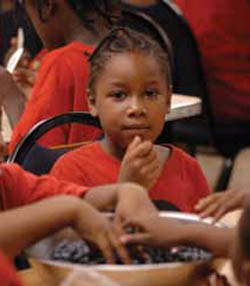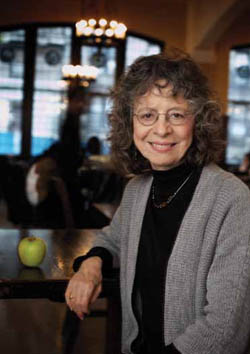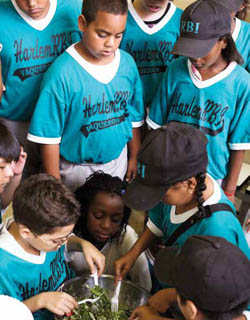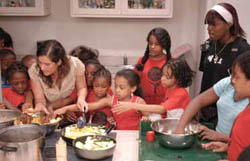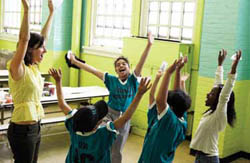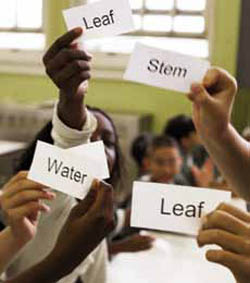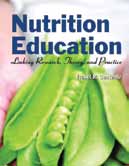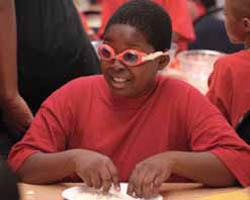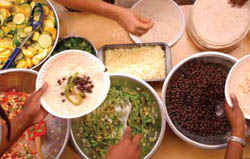Behaviorism in the Kitchen
TC's Nutrition Education Program is changing the way kids learn about a healthy diet, by getting them dicing, chopping, grating-'"and thinking
On a sweltering day near the end of July, Rachel Bartlett and Marcia Hays find themselves in the noisy cafeteria at the Academy of Environmental Sciences Secondary School in East Harlem . While more than 100 eight-, nine- and ten-year-olds dig into a lunch of pizza, corn and milk dished up on Styrofoam plates, Hays chops radishes and neatly arranges carrots and asparagus tips while Bartlett
By 1 p.m., the lunch hour is over and soon most of the kids—clad in a rainbow of Little League uniforms all emblazoned with "Harlem RBI," the insignia of a youth development nonprofit that combines an intensive reading and literacy program with baseball and softball—are off to their various activities. A few teams stay, however, and the members of one of them, the Lobos, make their way to the far end of the stuffy, blue-green and lemon-yellow dining hall, where they squeeze into seats at a cafeteria table on wheels.
“Lobos, we’ve been talking about plants. Now, does anyone remember what we talked about last week?” asks Bartlett, an easygoing woman in her twenties with shoulder-length brown hair and a substantial reservoir of patience.
A boy named Samir, sitting near the end of the table, pulls his cap down and raises his hand. “Seeds,” he says.
“That’s right. We talked about seeds. Today, we’re going to talk about roots and stems. Who can tell me what stems do?”
Four more arms shoot up, and the action begins. During the next hour and a half, Bartlett and Hays have the 13 kids chart the growth of bean sprouts they planted in plastic cups the week before; play a rowdy game of “Roots and Stems,” in which the kids pretend to be various plant parts; snap apart the celery soaked in red dye; figure out how to turn rolled up newspapers and bottle brush wire into a freestanding plant sculpture and, finally, sample carrots, radishes, onions and asparagus tips.
Welcome to nutrition education, Teachers College-style.
Both Bartlett (a graduate) and Hays (a current student) are products of TC’s Program in Nutrition, which is steering students on a new tack by having them teach children about nutrition by getting them to touch, cut, smell and otherwise get up close and personal with vegetables and other essentials of a healthy lifestyle. “With kids, you gotta get them involved,” Bartlett
Indeed, TC’s nutrition program, the oldest in the nation, has become a center for this more active, behavioral approach and has already published, through its Linking Food and the Environment (LiFE) program (a joint initiative with TC’s Science Education Program), three books for teachers that begin at the fourth grade and run through middle school. The books emphasize activities ranging from cooking and gardening to collecting and analyzing food and activity data. Yet potentially the most influential component of the program is a book published two years ago by Isobel Contento, the Mary Swartz Rose Professor of Nutrition and Education and director of the program. Reflecting 15 years of work by Contento, the book, Nutrition Education: Linking Research, Theory and Practice, lays out in detail a vision of nutrition education that is distinctly behavioral and psychological.
There was a day not all that long ago when Samir and all the other Lobos would not have gotten any chance to learn about nutrition through direct experience with food. The process would have involved a lot of telling, mostly about the four basic food groups, and at some point the food pyramid (now known as myPyramid) would have made an appearance. The operational theory of nutrition education was simply this: If you just made nutrition science interesting and understandable, kids would do the right thing. Research has shown, however, that telling kids what to eat doesn’t change their food choices, especially these days when less healthful food is heavily advertised and available seemingly everywhere, all the time. It’s no surprise, then, that the latest data indicate that more than two-thirds of Americans are overweight and the numbers are rising. Childhood obesity, meanwhile, is reaching epidemic proportions, with estimates that up to 16 percent of school-age kids are overweight—triple the percentage in 1980.
“I think a lot of nutrition education is still very information-bound, all about children knowing what the pyramid groups are and how they can place foods into those groups,” says Contento, a soft-spoken woman who becomes quickly animated in discussing her favorite topic. “I’ve always felt that is the most glorious waste of time. What difference does it make if a child knows that an apple goes in the fruits and vegetables group or that chicken goes in the meat and poultry group? Is that going to help them navigate today’s complex food environment?”
Over the past two decades, Contento has been attempting to push the field in a different direction. It isn’t so much that she is against giving children (or adults, for that matter) information about proper nutrition. What she has come to realize, however, is that information is insufficient to change behavior.
“Part of the challenge is that many of the people who go into the field of nutrition go into it because they are personally interested in the science of it,” says Pam Koch, a former student of Contento’s who now directs the LiFE program, through which the Harlem RBI outreach and a number of other projects in schools are organized. “So those of us who have an interest in nutrition are motivated by information, and it’s easy to think that the whole world is motivated by knowing information. But then when you start talking to people you realize that a lot of them know how to eat healthfully but don’t do it.”
For Contento, the solution is to conceive of nutrition education in three phases. The first phase involves enhancing motivation to make people want to move toward healthier eating. The second phase focuses on providing people with knowledge and skills to enact those healthier behaviors. The third step is providing support by making sure that healthful food is available. Environmental supports are part of the process because no matter how much you tell children to eat vegetables, if they’re served pizza at lunch and there’s a carbonated drink machine in every hallway, you’re fighting tough odds.
And how do you get people motivated? Contento has a ready answer: Attack the mediators. Mediators are those little filters we all carry around in our heads that say, “Yes, this is yummy to eat” or “No, that is strange or foreign or bad and I’m not having any of it.” It turns out that children have a slew of them.
In her textbook, Contento devotes an entire chapter to describing mediators and helping prospective nutrition educators identify them in the people they are seeking to help. “Understanding the interests, motivations, cultural values, and concerns of a given audience is very challenging because individuals’ food and physical activity behaviors involve many complex, and often conflicting, beliefs and emotions embedded in many aspects of their life histories and current life situations,” Contento writes. “But understand these we must if we are to design learning experiences that are meaningful and useful to the intended audience.”
That Contento would be among the leaders in the push toward a behavior-focused approach to nutrition education might seem a bit surprising given that her bachelor’s degree from the University of Edinburgh in Scotland (she’s the daughter of American missionaries who grew up mostly abroad) was in bacteriology, and her Ph.D. from the University of California at Berkeley is in microbiology with a focus on food and nutrition.
Yet by the late 1960s, when she was in graduate school, psychology was making substantial inroads into the nutrition education field, and Contento seized on it as a way to enhance the effectiveness of nutrition interventions. It would become the thrust of her research and development efforts after she arrived at TC in 1977.
She would go on to conduct a number of studies about children’s and adolescents’ knowledge and beliefs about food and food systems. The growing body of research in the 1980s and 1990s produced by Contento and others would drive her efforts to shape the nutrition education program at TC. “What we are attempting to do in our nutrition program and through our various initiatives is to have nutritionists learn enough about behavioral sciences in order to work effectively as behavioral nutritionists who are able to enhance people’s motivations to eat healthfully, and provide experiences for people to enjoy the taste of nutritious foods,” Contento says.
Kitchen as Lab
A few days after the Harlem RBI class, some 40 children from the St. Albans section of Queens file into a room in the basement of Horace Mann Hall that has the feeling of a high school biology lab. The room is equipped with three sinks, a stove with four electric burners, an industrial-size refrigerator and glass cabinets. There are no Petri dishes or beakers here, however. Instead, the walls are covered with pictures of fruits and vegetables, and at one end of the room is a display titled Food System Timeline, which runs several feet long.
This is the EarthFriends room, headquarters of a TC program that is designed to get kids right into the thick of things, rinsing, chopping, grating, cooking and, of course, eating. The kids from Queens—members of the Zen Masters Martial Arts Academy started by TC security guard Dennis Chambers who are on a field trip to the College—are crowded around several tables arrayed with cutting boards and squash, onions, green peppers, garlic, zucchini, corn, tomatoes and cilantro. Nutrition education student Luciana Ambrosi and nutrition and public health alumna Angelina Garefis quickly run them through the various parts of a plant and then inform them they’re in for a treat: they’ll be making veggie burritos.
For the next hour, they do just that. Ambrosi and Garefis pass out reusable plastic knives and set the kids about cutting veggies, shucking corn, and tearing cilantro into small strips. With the rice and beans already simmering on the stove, Ambrosi has the kids take turns sautéing the vegetables and then lines them up to get their veggies wrapped in a wheat tortilla.
“Everything you ate today came from a plant,” Ambrosi tells them after lunch. “Even the rice and the beans and the tortillas.”
“Why the tortillas?” Garefis asks.
A girl answers that tortillas are made of flour.
“Wheat flour,” Ambrosi affirms, “which comes from a plant. That’s pretty incredible. Everything we ate came from plants.”
The kitchen as a place for learning has significant historical roots at TC. Working with food was a big part of the curriculum at the Chicago
The nutrition education program builds on this heritage. The theory goes that when kids handle, cut, cook and eat vegetables, they form positive associations with healthful foods that may previously have been unfamiliar, helping them to develop a belief system that nutritionally will serve them well, so to speak, over the course of their lives.
“We try to embed those ‘Aha!’ moments that translate into behaviors,” Contento says.
For example, there is the story that Koch tells about an overweight teenage girl who attended one of her outreach nutrition courses some years ago through the Double Discovery Center at Columbia University
Or the student who blurted out to Bartlett Bartlett immediately turned what the student had said into a teachable moment: a discussion fueled by provocative questions from Bartlett Bartlett Bartlett
It’s hard to imagine lessons on the food pyramid, no matter how inspiring the lecture, resulting in such stories. Still, the question begs: Does the way TC is going about nutrition education work? And, if so, to what extent?
Contento is convinced that it does, and the research appears to bear her out. In 1998, Contento, Koch and colleague Toni Liquori, an adjunct professor in the program and head of the consulting firm Liquori and Associates, conducted an experiment at two New York City
The researchers took 590 kids and broke them into four groups, each of which was exposed during lunch to the targeted group of vegetables and whole grains. One group was taught nothing about fruits and vegetables; they simply showed up to the lunchroom. A second group was taught a classroom curriculum called Food and Environment Lessons, about the importance of eating vegetables and whole grains. The third group took part in a program called Cookshop, in which they got to cook the same vegetables and whole-grain recipes in the classroom that they were being served at lunch. That group also learned about the food, its nutritional value, and its history, as well as a little bit about botany. The final group participated in both Cookshop and Food and Environment Lessons.
What Contento and her team found was that the students who learned nothing about food and nutrition didn’t increase their consumption of vegetables and grains, throwing most of them away. The students who received the lessons on food and nutrition did eat more of the targeted food—but not much. It was the students who cooked the food (with or without the formal Food and the Environment Lessons) who significantly increased their intake of vegetables and grains. In other words, when the kids participated in a hands-on way, they had the greatest gains in preferences for whole grain and plant foods. Not only that, the students who actively participated showed gains in confidence from having acquired basic cooking skills.
For Contento, Koch and Liquori, the findings were a powerful indication that with the right approach, nutrition education can begin to change mediators and thus behavior, especially among children.
“There’s no question that Isobel’s work has been influential,” says Angela Calabrese Barton, a former TC colleague and now a professor of science education at Michigan State University New York New York City
onward and upward
In early August, Bartlett Bartlett
in anticipation.
in anticipation.
But even as Bartlett
The question of whether a cucumber or tomato or any other vegetable can ever compete with the flashy processed foods and syrupy drinks backed by multimillion advertising campaigns is one that has not escaped Bartlett Wake Forest University , she moved to New York
Published Friday, Dec. 4, 2009
